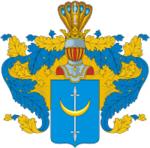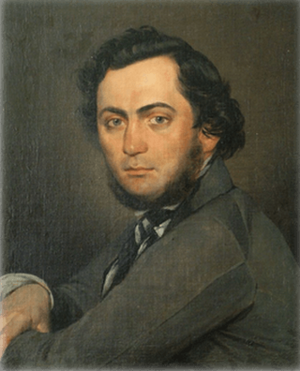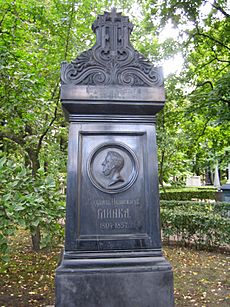Mikhail Glinka facts for kids
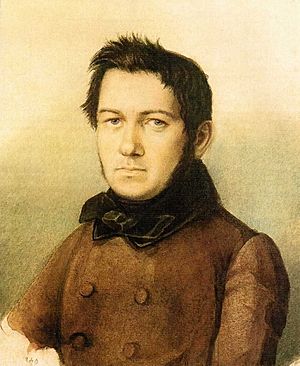
Mikhail Ivanovich Glinka (Russian: Михаил Иванович Глинка, tr. Mikhail Ivanovich Glinka, IPA: [mʲɪxɐˈil ɨˈvanəvʲɪdʑ ˈɡlʲinkə]; 1 June [O.S. 20 May] 1804 – 15 February [O.S. 3 February] 1857) was a very important Russian composer. Many people see him as the person who started Russian classical music. His music greatly influenced other Russian composers. This includes a famous group called The Five. They created a special Russian style of music.
Contents
Early Life and Learning Music
Mikhail Glinka was born in a village called Novospasskoye. This was in the Russian Empire, near the Desna River. His family was wealthy. His father had been an army captain. The family was very loyal to the tsars. Many relatives enjoyed arts and culture.
Mikhail was raised by his grandmother. She was very protective and spoiled him. She gave him sweets and kept him warm. Because of this, he often felt sick. Later in life, he always had doctors.
The first music he heard was village church bells. He also heard folk songs from peasant choirs. The church bells made a loud, clashing sound. So, his ears got used to unusual harmonies. The peasant choirs sang in a special way. They added improvised harmonies below the main tune. This helped Glinka create his own unique music style.
After his grandmother died, he moved to his uncle's estate. There, he heard his uncle's orchestra. They played music by famous composers like Haydn, Mozart, and Beethoven. When he was about ten, he heard a clarinet piece. It was by a Finnish composer named Bernhard Henrik Crusell. This music deeply affected him. He later wrote, "Music is my soul."
His governess taught him languages and geography. He also learned to play the piano and violin.
When he was 13, Glinka went to Saint Petersburg. He attended a school for noble children. He learned many subjects, including Latin and English. He also learned a lot more about music. He had piano lessons from John Field. Field was an Irish composer known for his nocturnes. Glinka then continued piano lessons with Charles Mayer. This is when he started composing his own music.
After school, his father wanted him to work for the government. Glinka became an assistant secretary. His work was not difficult. This allowed him to enjoy music as a hobby. He often went to social gatherings in the city. He wrote many sad romantic songs. These songs were popular with wealthy music lovers. His songs from this time are very interesting.
In 1830, Glinka traveled to Italy. A doctor suggested the trip for his health. He went with a singer named Nikolai Kuzmich Ivanov. They traveled slowly through Germany and Switzerland. Then they settled in Milan. Glinka took lessons at the conservatory. He found counterpoint (a way of combining melodies) difficult. After three years, he had listened to many singers. He also met famous people like Mendelssohn and Berlioz. But he became tired of Italy. He realized his goal was to go back to Russia. He wanted to write Russian music. He wanted to do for Russian music what Donizetti and Bellini did for Italian music.
On his way back, he stopped in Vienna. There, he heard music by Franz Liszt. He then stayed five months in Berlin. He studied composition with a great teacher, Siegfried Dehn. During this time, he wrote a Capriccio on Russian Themes for piano. He also started a symphony based on two Russian themes.
In 1834, Glinka heard that his father had died. He left Berlin and returned home.
Music Career
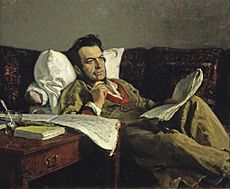
While in Berlin, Glinka liked a talented singer. He wrote Six Studies for Contralto for her. He planned to go back to her. But his sister's maid did not have the right papers to cross the border. So, he gave up his plan and his love. He went north to Saint Petersburg instead.
In Saint Petersburg, he met Maria Petrovna Ivanova. They married quickly. But the marriage did not last long. Maria was not interested in his music. Glinka's initial feelings for her inspired a part of his opera A Life for the Tsar. But his kind nature changed. His wife and mother-in-law often criticized him. When the marriage ended, Maria remarried. Glinka then lived with his mother, and later with his sister.
A Life for the Tsar was Glinka's first major opera. It was first called Ivan Susanin. The story takes place in 1612. It is about a Russian peasant and hero named Ivan Susanin. He gives his life for the Tsar. He leads a group of Polish invaders away from the Tsar. The Tsar himself watched the opera's progress. He suggested changing the title.
The opera was a huge success when it first opened on December 9, 1836. The Tsar gave Glinka a valuable ring as a reward. During the Soviet era, the opera was performed under its original name, Ivan Susanin.
In 1837, Glinka became the teacher for the Imperial Chapel Choir. He received a good salary and a place to live. In 1838, the Tsar asked him to find new voices for the choir. Glinka traveled to Ukraine. He found 19 new boys. The Tsar gave him more money for this.
Soon, he started his second opera, Ruslan and Lyudmila. The story was based on a tale by Alexander Pushkin. The plot was put together very quickly. So, the opera's story is a bit confusing. But Glinka's music in it is even better than in his first opera.
The opera's opening music uses a special scale. This scale is linked to the bad guy, Chernomor. He is a dwarf who has taken Lyudmila. There are many Italian-style singing parts. There are also ballet numbers. But Glinka's biggest achievement is how he used folk melodies. He wove them deeply into the music. Much of the folk music he used came from the East. When the opera first opened on December 9, 1842, people did not like it much. But it became popular later.
Later Years
Glinka felt sad for a year after Ruslan and Lyudmila was not well received. His mood improved when he traveled to Paris and Spain. In Spain, he met Don Pedro Fernández. Don Pedro became his secretary and friend for the last nine years of his life. In Paris, Hector Berlioz performed parts of Glinka's operas. Berlioz also wrote a positive article about him. Glinka admired Berlioz's music too. He decided to write some "picture-like fantasies" for orchestra.
Starting in 1852, Glinka lived quietly in Paris for two years. He often visited the botanical and zoological gardens. Then he moved to Berlin. After five months there, he suddenly died on February 15, 1857. He had caught a cold. He was buried in Berlin. But a few months later, his body was moved. He was reburied in Saint Petersburg. His grave is in the cemetery of the Alexander Nevsky Monastery.
The Start of a Russian Music Style
Glinka began a new path in Russian music. Before him, Russian music mostly came from Europe. But with Glinka's operas, truly Russian music started to appear. He often used historical events in his music. For the first time, these events were shown in a realistic way.
Alexander Serov was the first to notice this new direction. His friend Vladimir Stasov then joined him. Stasov became the main thinker behind this new cultural movement. It was further developed by the composers of "The Five".
A modern Russian music critic, Viktor Korshikov, said something important. He wrote that Russian music would not have grown without three operas. These were Ivan Soussanine, Ruslan and Ludmila, and The Stone Guest. He said these operas helped create composers like Mussorgsky, Rimsky-Korsakov, and Borodin. Soussanine is about the common people. Ruslan has a mythical, very Russian story. In Guest, the drama is more important than beautiful sounds. Two of these three important operas were Glinka's.
Glinka's work, and the work of those he inspired, was key. It helped create a unique Russian art style. This style is now very important in world culture.
Legacy
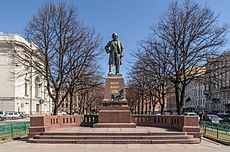
After Glinka died, people debated which of his two operas was better. This was a big topic in music newspapers. Especially between Vladimir Stasov and his former friend Alexander Serov.
Pyotr Ilyich Tchaikovsky said something famous about Glinka's orchestral piece Kamarinskaya (1848). He called it "the acorn from which the oak" of later Russian symphonic music grew. This means it was a small start for something big.
In 1884, Mitrofan Belyayev started the annual Glinka Prize. Early winners included famous composers. These were Alexander Borodin, Mily Balakirev, Pyotr Ilyich Tchaikovsky, Nikolai Rimsky-Korsakov, Cesar Cui, and Anatoly Lyadov.
Outside Russia, some of Glinka's orchestral music is quite popular. This includes the lively overtures to his operas. Especially the energetic overture to Ruslan. His other major orchestral works include a symphonic poem called Kamarinskaya. It is based on Russian folk songs. He also wrote two Spanish pieces: A Night in Madrid and Jota Aragonesa. Glinka also composed many art songs, piano pieces, and some chamber music.
One of Glinka's lesser-known works gained attention in the late 1900s. It was his "Patrioticheskaya Pesnya" (Patriotic Song). He supposedly wrote it for a contest for a national anthem in 1833. In 1990, it became the official song of the Russian Soviet Federative Socialist Republic. This was the only Soviet state without its own anthem. After the Soviet Union broke apart, this song remained the unofficial anthem. In 1993, it became the official Russian national anthem. It stayed that way until 2000. Then, it was replaced by the old Soviet anthem with new words.
Three Russian music schools are named after Glinka:
- Nizhny Novgorod State Conservatory
- Novosibirsk State Conservatory
- Magnitogorsk State Conservatory
A Soviet astronomer, Lyudmila Chernykh, named a minor planet 2205 Glinka after him. She discovered it in 1973. A crater on Mercury is also named in his honor.
A street in Berlin called Glinkastraße was named after him. In September 2022, a street named after Glinka in Dnipro, Ukraine, was renamed to honor Queen Elizabeth II.
Works
-
- See: List of compositions by Mikhail Glinka.
See also
 In Spanish: Mijaíl Glinka para niños
In Spanish: Mijaíl Glinka para niños


